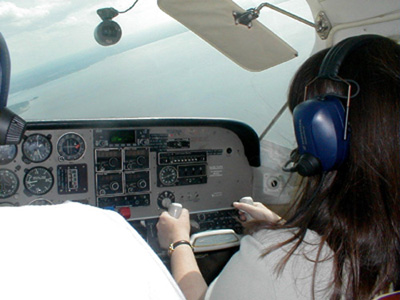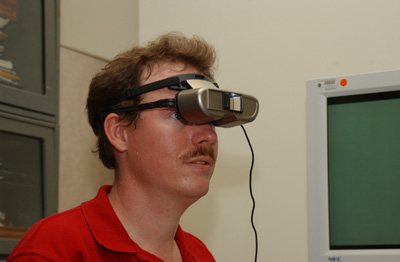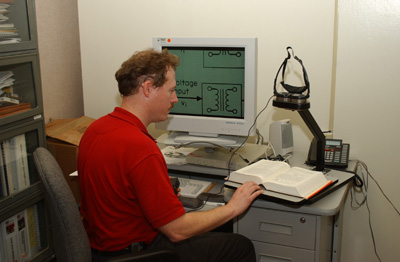How long does it take a ray of sunlight to reach the earth? Who was the first astronaut to eat in space? And what are Saturn's rings made of? If you're a person who gets easily distracted by fascinating facts, stay away from the NASA web site <www.nasa.gov>. NASA (the National Aeronautics and Space Administration) is only 45 years old, but in its relatively short life, it has been responsible for everything from putting people on the moon and searching for signs of life forms on other planets to inventing smoke detectors and Velcro. NASA has centers around the country, employing thousands of people--and many of those people are visually impaired or have other disabilities.
No Fear of Flying
Courtney Smith has always been interested in the space program. When she interviewed for various internships through a program at Mississippi State University, however, she calculated that her most likely possibility would be to get a job with a business-oriented company in the corporate sector. "I wasn't a science major," she explained, "so I didn't think I'd hear from NASA." But she was wrong.
Smith, a business-information major who has been totally blind since childhood, was offered a 10-week internship in summer 2001 at NASA's Goddard Space Flight Center (GSFC) in Greenbelt, Maryland. One interest that clearly emerged in her assigned tasks there was in the area of web-site accessibility. Upon her 2002 graduation from Mississippi State, she was offered a full-time position with Goddard as a full-time web-accessibility coordinator.
Before her job was created, no particular person was looking at GSFC's web sites to measure their accessibility to people with disabilities. In keeping with NASA's positive track record for using the talents of people with disabilities, serious attention was paid not only to compliance with Section 508 of the Rehabilitation Act (specifying that governmental sites must be accessible), but, Smith said, to go "beyond those requirements."
With 1,300 web sites at GSFC alone, there is plenty of work to keep Smith busy. Using a computer equipped with JAWS for Windows and an 80-cell PowerBraille display, she studies sites, writes accessibility instructions, and is generally available to take a quick look at a site that a coworker is updating.
Caption: Courtney Smith at the controls of a four-seater airplane.
At 26, moving 1,000 miles from a small suburb of Jackson, Mississippi, where she grew up, to Greenbelt and Goddard have been a bit of a culture shock for Smith. "Everything is just bigger here," she said, "and more confusing. But I think blind people need to go where the jobs are, and that often means traveling."
Inclusion in the workplace has never been a problem, Smith noted, although attitude shaping and awareness raising are still needed in some extracurricular areas. Smith's love of theater and music was a ready match for GSFC's music and drama group, where she has a role in the upcoming performance of Barnum. But when she joined the flying club, there were those who had a hard time accepting her.
"I've only flown a little four-seat Cessna," Smith demurred, "and that was with assistance. You need a sighted person's help, but in a small plane like that, you can tell quite a bit about what's going on from the sensations." Adapting instruments to let a blind person know when a plane is climbing or rolling to the left or right should be fairly easy, she said, just as web sites are made readable to screen readers with the addition of intelligible alt tags. "All of Goddard's web sites are pretty accessible already," she explained, "but we try to go beyond 508 compliance."
Caption: Courtney Smith at her desk at Goddard Space Flight Center.
Managing Well
Although Smith's job as a web-accessibility coordinator is new, many other blind people have worked for NASA in a refreshingly broad range of categories. Chemist, computer scientist, mathematician, project manager, and even astronomer are among the titles of a variety of talented NASA employees who are blind. For example, Paul Mogan, who has worked at the Kennedy Space Center near Orlando, Florida, for 14 years, has served as project manager for undertakings that have garnered $13 million budgets and 30-person teams and has even been part of a group that was responsible for a patented NASA invention.
"NASA develops all kinds of technology that is patented and then farmed out as commercial product," Mogan explained. In his case, he and a group of colleagues developed an instrument to measure the amount of contamination that is deposited on equipment in a "clean" work area. (Other familiar products that were invented by NASA employees include bar-code scanners, smoke detectors, and Velcro.) Projects that Mogan has coordinated have included those related to energy consumption and weather. He explained that the object of the energy study was to examine how much energy is used to operate various buildings at the KSC facility to find ways to be more efficient. An example of a weather project was one involving lightning--predicting how often and where it will occur. "Lightning's a problem when you're launching rockets," he pointed out.
Mogan, who was diagnosed with Stargardt's disease at age 3 and has been legally blind since age 18, has been with NASA for 14 years. NASA has been wonderful about accommodating his needs as a person with low vision, Mogan said. His employers have purchased the ZoomText Extra (screen magnifier/screen reader) that enables him to use his computer; a collection of handheld magnifying devices; and, perhaps his favorite low vision aid, the Jordy. A head-mounted device, the Jordy resembles a pair of binoculars, offering two displays (one for each eye), for magnifying print. Although Mogan's vision is only 20/600 with correction, the Jordy makes it possible for him to fill out forms and handle other printed material visually that was previously impossible. It also has video output that allows it to serve as a video magnifier.
Caption: Paul Mogan wearing the head-mounted Jordy low vision device.
The transportation system at Kennedy is particularly friendly to people with disabilities, Mogan said. In addition to a regular shuttle that transports employees from building to building, drivers are available for individual trips to facilities farther away. "If I have a meeting or training class in Cocoa Beach," he cited as an example, "which is about a half hour away, I just call a day or so ahead, and one of the drivers is assigned to me for that trip."
When Mogan first interviewed at Kennedy, he remembers being told that employees with better vision than his had been retired from NASA as disabled. Still, his conviction that there is always a way to do something if you want to do it was sufficiently persuasive. He has not only proved himself to be a valuable NASA professional, but has extended his zeal beyond assigned work. The Jordy, for example, has undergone improvements because of his suggestion that the product should be made smaller and lighter and offer greater image stabilization. Mogan teaches others to use low vision products and oversees a group of students at Georgia Tech who, under an agreement with NASA, are working to improve the Jordy. "I'm just a regular person," Mogan said, "who wants to contribute and who wants to improve my situation and the situation of other disabled people. I want to give disabled people one message: You can do it!"
Caption: Paul Mogan at work at Kennedy Space Center using the Jordy as a video magnifier.
Molecular Magic
At NASA's Marshall Space Flight Center in Huntsville, Alabama, research chemist Craig Moore uses his specialty in quantum mechanics to study the properties of molecules, collecting and examining data to analyze them statistically. Totally blind since birth from retinopathy of prematurity, Moore said that he developed an early interest in mathematics and chemistry partly because of the encouragement of a scoutmaster in his Boy Scout troop in North Dakota. In 1981, while Moore was working on his doctorate in physical chemistry at the University of Cincinnati, a friend assembled a CP/M-based computer for him (CP/M is an early operating system similar to DOS) using "pieces salvaged from other machines" to create a unique system. Moore and his friend successfully interfaced the system with a braille display from Germany, a feat that enabled Moore to use the system not only as a word processor and a calculator, but as a mainframe terminal. For that era, Moore believes, he may well have been the first blind person in America, or certainly among the first, to use a refreshable braille display to read computer output. Without such access, he cannot imagine accomplishing his work.
Today, Moore, age 46, divides his time between Huntsville and Atlanta, where he frequently works with a colleague on research projects. Working off-site, he said, is an accommodation that is available to many NASA employees, with and without disabilities, but one that has worked particularly well for him.
Moore explained his complex work for the layperson as "studying simulations of different molecules, looking at them to see things like how fast they absorb light, how stable the molecule is, and how rapidly reactions occur. . . . Right now, we're looking at semiconductors, trying to make one with nitrogen and a new metal called indium. Gases are injected into it, and we look at the deposits that form. There are a lot of reactions, and we look at numbers and predict what kind of reactions there will be and how rapidly those reactions will occur." A practical application of such a study, Moore explained, would be the development of a material that would facilitate the storage of more data on a CD or DVD disc. While the uninitiated may expect that such work would be highly visual, Moore said that he has rarely used graphics or felt the need for them. Molecules are represented by coordinates, and numbers represent the energy of the molecules; everything, in short, is expressed in numbers.
For Moore, these numbers are conveyed through the JAWS screen reader and a refreshable braille display. At work, he uses an 80-cell ALVA, while off-site his 40-cell Millennium personal organizer doubles as a braille display. When the necessary information is conveyed in Greek symbols, however, he then needs sighted assistance to interpret them.
Accommodations throughout his 15 years at NASA--and, for that matter, in his days as a doctoral student--have always been available to him. Moore believes that the availability of accommodations may be due, in part, to the elitist nature of the work he does. Chemists, physicists, and engineers tend to be solution oriented, and hence have provided any pragmatic assistance he may have occasionally needed. In addition, supervisors have generally been helpful. Moore views every accommodation and piece of equipment as significant, however, stressing that "it's not trivial, my getting things that I need."
Facts at Her Fingertips
When Jill Noble was a computer science major at Cleveland State University, another college student told her about internships at NASA's Glenn Research Center in Cleveland. With characteristic assertiveness, she called the hiring manager and landed two summer internships, in 1985 and 1986, as a computer programmer. When an opening occurred in the same department three years later, Noble was hired full time. Today, at age 42, she is an assistant administrator on "the business side of the house," no longer programming but still putting those computer--and other--skills to work.
One of Noble's main jobs is to maintain the center's Master Data Locator System, a database of all current and retired employees. Containing such information as the employee's title, position, room number, mail stop, and employment status (whether the employee is a civil servant or contract employee or has another status), the database is updated nightly from three sources and is constantly being changed. When Noble began with NASA as a programmer, her primary tool for access was a tape-based VersaBraille, the first widely distributed refreshable braille device for storing and retrieving data. It had a standard Perkins-style braille keyboard and stored data on cassette tapes. Noble has been through many generations of computer equipment since then, she said, and today uses JAWS for Windows and a 70-cell Tieman Braille Voyager refreshable-braille display to do her work. At this point, she noted, the braille is essential: "For one thing, I'm on the phone a lot, verifying an address or phone number or other fact about a person, and I couldn't do that without the braille."
Managing the database, however, is only part of her job with NASA. As a member of the Glenn Center's speakers' bureau, Noble travels once or twice a month to schools, civic organizations, or church groups who want to know something about the work that NASA does. "The two presentations I do mostly," she said, "are about the solar system and living in space." Videotapes and slide presentations often accompany such presentations, but Noble noted that these visual elements are no problem, since she has ready access to all the corresponding text. She is something of an ambassador for her employer in other ways, too. She enjoys conducting tours of her building or other parts of the 300-acre complex that comprises over 100 buildings. "Of course, there are still lots of buildings here that I don't know," she explained. As for traveling from one building to another, Noble said that a van is available, but she prefers "using my feet."
Other projects she has undertaken have included coordinating the production of a new disability-awareness video in conjunction with her role as a member of the 12-person disability advisory group. The group hosts awareness days for other employees and makes recommendations for improving access to the center's many buildings.
In addition to computer equipment and an available shuttle service, Noble noted that her employer has accommodated her in smaller, more personal, ways. "I've been given a key card for evening access to the building," she explained, "so that when I work evenings, I can take Cadet"--her guide dog--"outside and get back into the building." Another "accommodation," she pointed out with a laugh, is that "they keep a garbage can in the same spot, so I can find it when I take my dog out!" One accommodation that Noble hopes will be eventually added is telecommuting. "I love my job," she said with enthusiasm, "and I love coming to work." Her hour-long commute each way, however, involves traveling by train and bus, and when the snow falls in Cleveland, the option of working from home would be a welcome one.
Accommodations Over Time
Although all these individuals are valuable NASA employees--and all happen to be blind or have low vision--they are by no means rare exceptions in the NASA workforce. Of the 19,000 NASA employees, communications specialist Eldri Ferguson said that 1,131 have disabilities, and about 757 more choose not to be identified as disabled.
Employees with disabilities can be found at every NASA location, and the trend is not a new one. John Bogert, who was hired as a mathematician in 1969 to write computer programs for scientists in the Laboratory for Astronomy and Solar Physics, shares many examples of how he, a totally blind person, was accommodated over 30 years ago. "I'd never even seen a computer at the time," he said, "had no idea how a "program" worked, and no clue how to communicate with the machine. . . . With the help of many coworkers, I got braille output from the old 1401 IBM printers they used back then, learned FORTRAN, and started warping downlinked data into something more or less interpretable for several ace astronomers." Bogert, who is now near retirement, is quick with a joke about his role at GSFC. Resisting the title of computer scientist, he said that he runs a few programs to "keep the dinosaur breathing" and to give supervisors "headaches about accessibility."
NASA hired Bogert over 30 years ago, but the recently expanded strategies to recruit people with disabilities are new. Michael Hartman, GSFC's equal employment opportunity representative, commented, "Goddard has made it standard operating procedure to contact the campus office of services for students with disabilities when we go to a college or university for recruiting purposes. We also try to visit schools that have a critical mass of students with disabilities."
Goddard has programs that target high school students with disabilities and paid summer internships for those in college. ACCESS (Achieving Competency in Computing, Engineering, and Space Science), a program funded by NASA headquarters and managed by the American Association for the Advancement of Science (AAAS), is an agency-wide recruitment effort that places college students with disabilities in paid internships each year.
In an agency-wide commitment to expanding the recruitment efforts of people with disabilities, each center has some plan in place--to attend conferences, visit schools, place advertisements in relevant publications, and so forth. Goddard has collaborated with the National Federation of the Blind in developing an initiative that includes the accessibility of technology, education and outreach, and employment.
NASA Trivia
Clearly, NASA is an employment environment in which people who are blind or have low vision have long been recognized for talents ranging from mathematics to science and engineering to business and in which thriving and advancing are often possible. And if you're still wondering about those bits of NASA trivia, the answers are eight minutes, John Glenn, and ice chunks. But here's another piece of NASA trivia to contemplate: The names of the first African American, first woman, and first teacher in space are all facts available on NASA web pages. When, we can only wonder, will the name of the first blind person in space be added?



